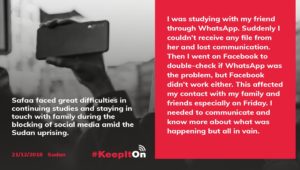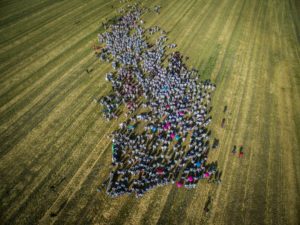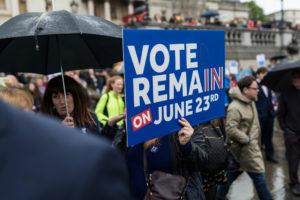Between 9 June and mid-August 2019, Hong Kong hosted three protests involving over a million people — one quarter of the city’s population.
The first demonstrations stood in opposition an extradition bill that would have opened the door for arrested Hong Kongers to be sent to mainland China, where a fair trial is far from guaranteed.
The city’s leader Carrie Lam refused to back down, and in that vacuum, protesters developed five demands. These include the complete withdrawal of the bill (which Lam announced on 4 September that she will commit to); an independent inquiry into police behaviour during the protests; a retraction of the government’s characterisation of protesters as rioters; an amnesty for protesters; and the right for all Hong Kongers to vote for their city’s Legislative Council and Chief Executive.
This movement is highly creative and has managed to mobilise millions. In doing so it offers many important lessons for advocacy campaigners, including how to hold together different theories of change, cultivate distributed leadership, and operate in a radically participatory form.
Handling different theories of change
It’s not uncommon for tensions around theory of change to divide movements. Often, more militant groups that use direct action or take a confrontational approach are seen to be in conflict with mainstream strategies. And, even where there is dialogue between these groups, it is often difficult to coordinate these different approaches.
The current movement in Hong Kong has largely been able to avoid such internal conflict, thanks to reflection on past experiences and its adoption of a broad set of principles.
On the ground, the movement has two different but co-dependent wings. The first is a big and emphatically peaceful wing manifest in the large protests organised by the Civil Human Rights Front — a platform convening dozens of local NGOs and political parties — and other older pro-democracy organisations.
Alongside it is a younger, more militant wing. These activists clad in goggles, masks and helmets, dressed in black and carrying umbrellas contest power differently. With fresh memories of the tear gas used in the 2014 Umbrella protests, they take to the streets prepared for conflict with the police.
They aren’t strictly Gandhi-esque, but nor are they openly violent. Instead they flirt with the line between non-violent and violent protest, disrupting the usual functioning of the city in order to demonstrate that people have withdrawn their consent for how the city is being governed. At the same time, they non-violently invite the police to behave aggressively in order to put the brutality of the state on display to the world.
The 2014 Umbrella movement, in which participants staged a 79-day-long sit-in to demand genuine democratic elections, was defined by inter-organisational and inter-generational conflict. The coalition that coordinated the action included younger activists and older democrats, and on both sides trust was limited and disagreement was rife. This made it virtually impossible to find a strategy beyond agreeing to let the occupation continue. Consequently, the only solution was to let the occupation continue until it was disbanded by police.
The tensions from Umbrella were never depolarised face to face, but a rich set of reflections began to develop online. In May 2019, a discussion forum similar to Reddit, called LIHKG, became a space for organising involvement in the 9 June protest. It also became a place for developing broader strategy — and in doing so participants examined how they could avoid the deep friction that dominated Umbrella.
A new set of principles were identified that sought to overcome the problems of the past. These principles included “everyone has a place,” to “not be divisive” and to “not leave anyone behind”. Leaders were resolute in holding to these principles across the movement.
In practice, this meant that whether you were a younger or older activist you had a role, and no one had the right to stymie your leadership. This new approach created space for older, established groups to convene demonstrations, and for younger protesters to develop their own approach.

Creating a leaderful movement
The 2014 Umbrella protests were coordinated by a relatively small group of leaders. After Umbrella ended, authorities came after those identifiable leaders — charging them with various offences and imprisoning them. The aggressive retribution was designed to have a chilling effect.
However, those jailings — some of which happened as late as April 2019 — have in effect sent a message that everyone needs to be a leader. As one activist described to me, “In the past we looked to the stage, but the stage was now in jail.”
More leaders produced a much larger and more decentralised movement in 2019. Take the Lennon Wall. This idea, adapted from a graffiti wall in the Czech Republic, was a protest wall of post-it note messages built in a single stairwell during Umbrella.
In the 2019 movement, the Lennon Wall became deeply decentralised across the city. Every public transport station has one. There are hundreds of walls with millions of messages across the city.
Similarly, the act of protest is much more fluid. Umbrella was an occupation restricted to fixed sites that required lots of work to maintain things like toilets and other basics.
In contrast, the 2019 protests travel all across the city from the New Territories to Kowloon. They amass great confronting force, but also have the power to disperse quickly — the “be water” technique in action.
Using apps like Telegram, AirDrop and newly developed mesh bluetooth networks that work without the internet, protesters organise themselves into small cells and assign roles. In a matter of minutes a place can go from empty to hosting a blockade, where protesters generate disruption, for instance by tying together fences to block traffic. Protesters often tease the police, some staying but many leaving, with the aim of creating sites of conflict across the city and thereby confusing the police about were they should be.
Beyond the younger protesters, older activists also practise “be water” by hosting district Telegram groups and organising town hall events in all of Hong Kong’s districts. Additionally, they have created support groups for the younger protesters, such as spaces to provide health care outside of hospitals (where there is a fear of police intimidation), or used their cars to pick up stranded protesters if public transport is shut down.
This decentralised and leaderful approach, combined with the big protest marches, has helped the movement maintain greater public support. Rather than separating an occupation from the rest of the population, the movement is everywhere, and local places instead of institutions serve as democratic anchors.
Fostering open participation that transitions from online to offline
The movement isn’t only leaderful, but it is also highly participatory.
Using the Reddit-like LIHKG website, participants suggest campaign ideas and tactics anonymously, where they are debated and voted on. Entire events are birthed online (like the Hong Kong Way protest where people held hands across Hong Kong Island), as well as particular strategies (e.g. people debated the merits of a militant occupation of police headquarters at the 18 August rally, and it was rejected as a majority thought it would take away from the peaceful intent of the march).
This open space has created an energy for innovation: there are poster competitions where artists and graphic designers compete to produce the most popular and most beautiful materials for the protests. No one has to wait for central decision makers to take action.
Indeed, the movement’s approach is the opposite of a typical “command and control” style of campaign where staff design strategy and comms and then blast these materials out with instructions to supporters.
Underpinning this participatory philosophy is the idea that everyone needs to be a leader. If the leaders on the stage get arrested, then the people in the crowd need to lead. This emancipatory approach lies at the heart of the Hong Kong protests and is key to why the movement has proven so effective.
Want to learn more? Amanda Tattersall hosts the ChangeMakers podcast, which has just released a series of episodes digging deeper into what’s going on in Hong Kong. Check them out!
Top image: Causeway Bay, Hong Kong. More than 1 million marched in protest against controversial extradition bill on 9 June 2019. Photo by Joseph Chan on Unsplash.




